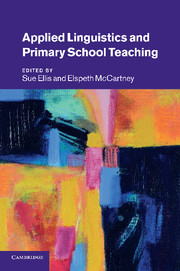Book contents
- Frontmatter
- Contents
- List of figures
- List of tables
- Notes on contributors
- Preface
- Editors' notes and conventions
- Introduction
- Part I Policy and diversity in the twenty-first-century primary school
- Part II The range and focus of applied linguistics research
- Introduction to Part II
- 6 Grammar for designers: how grammar supports the development of writing
- 7 The use of corpus-based approaches in children's knowledge about language
- 8 Words and pictures: towards a linguistic understanding of picture books and reading pedagogy
- 9 From storytellers to narrators: how can the history of reading help with understanding reading comprehension?
- 10 Talk about text: the discursive construction of what it means to be a reader
- 11 Why we need to know about more than phonics to teach English literacy
- 12 Understanding children's reading comprehension difficulties
- 13 Classroom discourse: the promise and complexity of dialogic practice
- 14 Pedagogy and bilingual pupils in primary schools: certainties from applied linguistics
- Part III Empowering teachers and teachers' use of knowledge
- References
- Index
8 - Words and pictures: towards a linguistic understanding of picture books and reading pedagogy
Published online by Cambridge University Press: 26 April 2011
- Frontmatter
- Contents
- List of figures
- List of tables
- Notes on contributors
- Preface
- Editors' notes and conventions
- Introduction
- Part I Policy and diversity in the twenty-first-century primary school
- Part II The range and focus of applied linguistics research
- Introduction to Part II
- 6 Grammar for designers: how grammar supports the development of writing
- 7 The use of corpus-based approaches in children's knowledge about language
- 8 Words and pictures: towards a linguistic understanding of picture books and reading pedagogy
- 9 From storytellers to narrators: how can the history of reading help with understanding reading comprehension?
- 10 Talk about text: the discursive construction of what it means to be a reader
- 11 Why we need to know about more than phonics to teach English literacy
- 12 Understanding children's reading comprehension difficulties
- 13 Classroom discourse: the promise and complexity of dialogic practice
- 14 Pedagogy and bilingual pupils in primary schools: certainties from applied linguistics
- Part III Empowering teachers and teachers' use of knowledge
- References
- Index
Summary
Introduction: picture books and pedagogy
Picture books have long had a place in the primary classroom. Bright colours, pleasing formats and good stories have attracted both teachers and children. Teachers have recognised their usefulness in convincing children that reading is worth the effort it involves, and children have delighted in the possibilities of play they offer: they have readily engaged visually, emotionally and intellectually with the ideas on the pages.
For some years, in some infant classrooms, picture books took on a central place in the pedagogy of reading. Waterland (1985) and Ellis and Barrs (1996) showed how skilful teachers might construct from picture books a programme for initial reading tuition, and Meek (1988) went some way in explaining how this worked at a theoretical as well as a practical level. She wrote of the rich, but untaught ‘lessons in reading’ that were afforded by the best books that readers read, and showed how texts such as Rosie's Walk (Hutchins 1969) and Each Peach Pear Plum (Ahlberg 1976) taught children not just how to read the words, but how to think like a reader.
One might have expected that by 2009, a complete and systematic pedagogy for learning to read with picture books would have been developed, but this has not happened. Changing priorities in educational policy in England, for example The National Literacy Strategy (DfEE 1998c), focused attention on reading skills and measurable progression in reading and these ideas sat uneasily with Meek's less tangible concepts of developing an understanding of irony and entering into conspiratorial pacts with authors.
- Type
- Chapter
- Information
- Applied Linguistics and Primary School Teaching , pp. 107 - 117Publisher: Cambridge University PressPrint publication year: 2011
- 2
- Cited by



